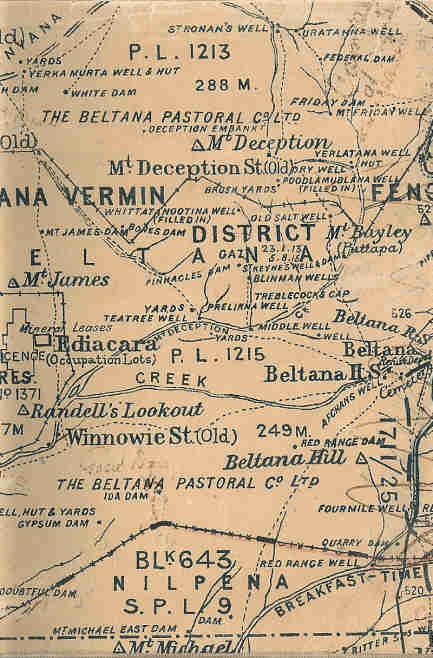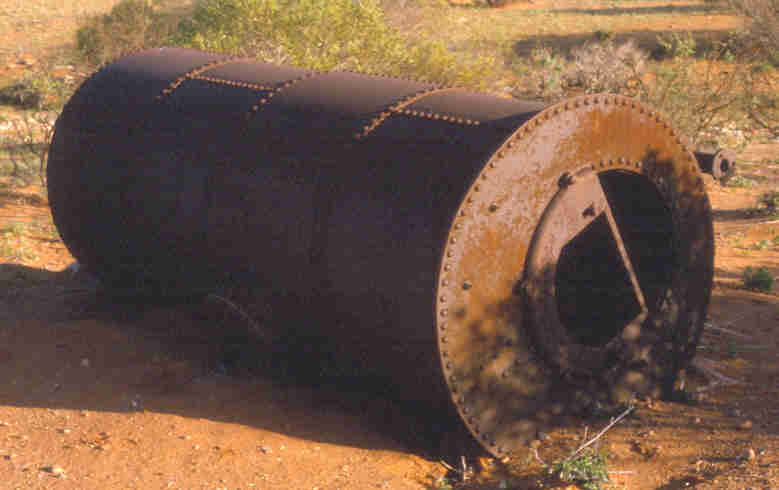


|
|
South Australia's Mining Industry.Silver mining (part 3)
While Beltana, and the surrounding area, was still being advertised as 'The Coming Silver Mining District of the North', services on the silver fields were at times rather poor. There was a post office at the Ediacara mine, but mail was only delivered twice a week. A boarding house, which had operated and catered for some twenty miners was in danger of being closed down, and Mr Shepherd of Blinman who had operated a store on the field had it removed due to a lack of business. By the middle of 1890 it looked as if the Ediacara mine was really going ahead. During May the mine had been inspected by Professor F.M. Krause of the School of Mines from Ballarat. Concentrates of the mine had been sampled by the English and Australian Copper Company at Port Adelaide giving encouraging results. By the middle of July though, all the men and boys who had been working on the concentrators were discharged, as was the mason. The cutting and carting of firewood was stopped and all but thirty miners were dismissed. On top of that the manager also resigned. Soon after that the leases of the New Ediacara and the Beltana North were amalgamated with the Ediacara Consols Silver Mining Company N.L. On 29 June 1891 the company made a call of two shillings per share to increase its capital. A few days later the new manager, W.H. Corbould arrived to take over from Mr W.E. Dalton and direct the many different operations. Not yet twenty-five years old, Mr Corbould was already considered an expert by Captain Morish who had arranged the position for him. William H. Corbould was the son of a Ballarat tailor and had been educated at the famous school of mines there. Before coming to the Ediacara mine he had been involved as an assayer at Silverton and Broken Hill. At about the same time the government had instructed their surveyor, E.C. Playford to survey a township near the Ediacara mine. Playford laid out 260 townlots and by the end of the year there were five boarding houses, two butchers, including John Alfred Harry, one baker, two fruit shops, C.R. Shepherd's building firm, and three general stores, including the one run by Mr F.M. Buttfield. Miners did need a licence to occupy the newly surveyed townlots and before long about two hundred people lived at Ediacara. Arthur Wellington Ware was granted a licence to operate the Ediacara Hotel 'subject to a verandah being put up, 9 feet wide on two sides'. Several people applied for an occupation licence, but did not live on the blocks. Some of these were F.M. Buttfield, A. Doig, J.R. Harvey, Ah Sing and J.J. Doig. Among those who did live on the blocks were Mr and Mrs J. Harvey, R. Renfree, C. Gray, John Gray, A.C. Ferguson, W. Tonkin and J. Verco. At the mine itself 'great strides of development were being made and were at a stage where more machinery was indispensable'. The directors had decided to invest in one of the May Brothers' improved automatic pulsating concentrators or jigging machines with plunger action, and in four compartments. Captain Truscott, on a recent visit to the Barrier, inspected one of these concentrators working at the Umberumberka mine, and spoke very highly of it. By August 1892 this machinery was in place and reported to be working well. Early in 1892 William H. Corbould started the sinking of a shaft which at the end of the year had reached a depth of about sixty metres. He also had installed a twelve inch pump, but water at a rate of about half a million gallons kept coming in faster than it could be pumped out. Several other and bigger pumps were tried but to no avail. The last pump broke down in December. Other shafts were sunk at different places, one to a depth of sixty-seven metres. As the company was running out of money and the flow of water could not be managed, it was decided to stop trying and dismiss all the men and close the mine for the time being.
Both Corbould and Tom Barnfield then left for London in the hope of obtaining money, but they were unsuccessful. Corbould resigned and headed for Western Australia where he tried his luck on the goldfields. From there he eventually moved to Queensland where he worked between 1910 and 1922 at the Mount Elliott mine near Cloncurry. Finally this son of a Ballarat tailor became involved with the Mount Isa mine in 1923 where he made a lasting impact and important contribution to the success of this giant enterprise. During October 1892 work was again pushed ahead with new pumping gear, which had been obtained from Fulton and Co. and was on its way to the mine. Captain Morish, who was now the managing director of the Ediacara saw excellent prospects of a big future ahead. As the need for more money was obvious, the New Ediacara Consols resorted to making calls upon their shares. The seventh such call was made during June 1893 and shareholders were warned that shares on which the call of one penny was not paid would be forfeited and sold by public auction on 25 July. Barely three months later the directors were forced to make an eighth call of one penny. Somehow though, this big future that was supposed to lie ahead did not materialise. Even so, some promoters still believed that silver did exist in the north. As late as September 1893, the New Warrioota Silver Mining Company was formed, but most miners had left the silver fields and the surveyed Ediacara blocks. The town itself was never officially proclaimed. In 1893 the Post Office was closed, but James Hardy still provided the service of butcher. Several companies had been wound up and on 7 December some of their mineral leases were auctioned at the Land Office in Adelaide. Silvermania had also run its course. Finally in 1899 the Government itself became involved. It had some drilling done during that year and about twenty tons of ore were raised. However both the high cost and the poor results obtained forced its abandonment. The hopes of mining silver from the Ediacara field was not yet completely given up. In 1901 the Beltana mine was re-opened and worked for nearly two years. George Ainsbury of Lyndhurst worked on the field in 1901, and during the next year it was worked by the Queensland Smelting Company. All hope seemed to have been given up in 1905. During that year the machinery at the Ediacara mine was dismantled and transported to the Paull's Consolidated copper mine. But within two years all of this was forgotten. On 7 February 1907 the Ediacara Proprietary Mines was formed to acquire the mineral leases held by Henry Gilbert Stokes. This new company tried to issue ten thousand $2 shares to finance its venture and pay Stokes three thousand fully paid-up shares. Among its Adelaide directors were T.S. Backhouse, W.J. Hill, R.L. Scott and W. Hamilton. Thomas S. Backhouse had previous experience with the Northern Flinders Ranges. As a broker and mining agent Backhouse had been heavily involved with the goldrush at Worturpa. Better rewards came his way in 1906 from the Western Australian goldfields. These directors appointed Mr Henry Stokes as their mine manager. Within six months it was reported that the Ediacara mine was 'absorbing a lot of surplus labour'. More than forty men were again at work. A month later this had increased to seventy men and both 'mining and smelting were in full swing'. On the company's second property, the Warrioota Lead Mine, good ore had also been found and modern technology was applied to its fullest extent, including a new water-jacket blast furnace and probably the only mining plant in Australia worked by gas, which is manufactured by passing steam through coke. The cost is much cheaper than is the case with steam. Unfortunately the proceeds were not enough to cover all the cost and on 13 December 1907 the Ediacara Proprietary Mines was wound up, all men dismissed and the mine closed. Very little work was done during the hot summer months, but during autumn 1908 the Ediacara nine was re-opened under the direction of Mr Wesley, who had hired nine men to start the mine once more. This last attempt met with very little success and only about fifty tons of ore were produced. As late as 1947 leases on the Ediacara field were held by the Austral Mining and Smelting Company. Two other attempts were made to mine silver in the Northern Flinders Ranges. One was tried in 1890 by a company from Broken Hill, called the Flinders Silver and Lead Mine Company which tried its luck at Mount Freeling. Here David Hutton and Edwin Barnes prospected for more than four weeks, and according to J.J. Christmas, the company's secretary, they were 'sanguine that Old Mount Feeling will be one of the largest mining centres in South Australia in a very short time'. The other attempt was made at Murnpeowie Station. Here the Ooloo Silver Lead Mining Company N.L., formed on 8 January 1936, bought claims no. 11,850, 15,099 and 15,098 from Hermann Rieck for four hundred fully paid up shares of $10. With the remaining three hundred shares they hoped to develop the mine. The first directors of this company were Hirsch Krantz of Magill, Wilton G. Venus of Fullarton, Otto Heysen of Tusmore and Hermann Rieck of Port Augusta. A fair amount of work had already been done by Mr Rieck who had opened up two distinct lodes showing lead, silver, zinc and small quantities of gold. Two shafts had been sunk, one of ten metres on the southern side and another shaft of twenty-three metres on the northern side of the lode. An offer to buy the ore had been received from O.T. Lenspriere and when a hundred shares had been sold the company proposed to start further work. By February 108 shares had been sold and work was commenced. A year later, Krantz as chairman, reported to the board of directors that a loss had been made. Additional finance was badly needed and provided on 26 April 1938 when share capital was increased with an issue of 63,000 shares of $1 each. But again to no avail, and a year later the company was wound up voluntarily. The original shareholders came from all walks of life and from all over South Australia, including Eyre Peninsula. Joseph Henry Turner from Cowell had seven shares. He would have been very familiar with the Northern Flinders Ranges. Both his parents came from the north and were married on 12 December 1876 at Mount Lyndhurst station where they were working at that time. Joseph was born in 1888 at the height of silvermania at Mount Lyndhurst. Very little evidence of this silvermania is left, either at Ediacara or any of the other fields. Iron and timber buildings were taken down leaving only a few scattered and blackened chimneys as reminders of places where once families lived and hoped to secure a steady income. Also remaining are the balances of Government subsidies which have never been repaid. The Ediacara Consols Silver Mining Company N.L. received a total amount of $1,300 but only paid back $930. Near the many old mines there are still many shafts and some mining gear, such as ladles and boilers. These once important and expertly made boilers (no welding, only riveting) are now rusting away all over the Northern Flinders and in the sand dunes of the plains of silver near Lake Torrens.
*** If you would like to find out more,
|



